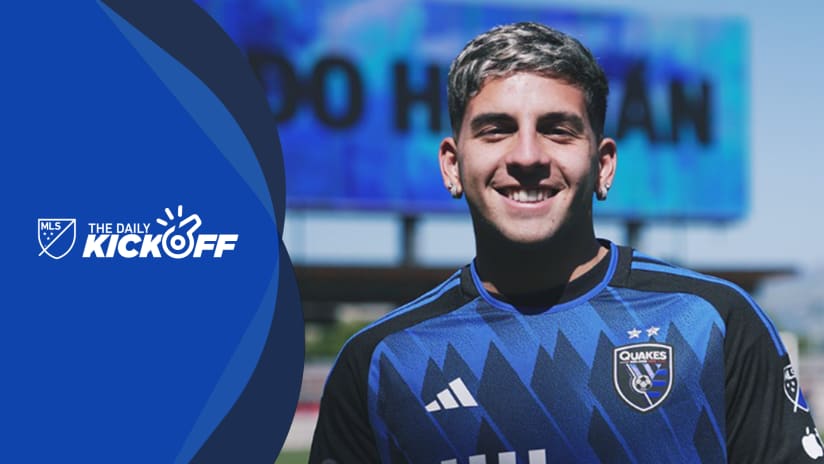There's a great behind-the-scenes clip from the old USMNT documentary called "Our Way: The Story of the United States' 2002 World Cup Journey" in which then-head coach Bruce Arena is pumping up his charges ahead of the opener against Portugal.
"First foul, first card, first shot, first goal," Arena fairly screams at the likes of Landon Donovan, John O'Brien, Brian McBride and Earnie Stewart. You can see that they're buying in not just regarding what Arena's saying, but also regarding what he actually means: Go out there and set the tone. Punch them in the mouth and make them fear you in the first 10 minutes, and take control of this game.
That is, of course, exactly what happened. The US hung three on Portugal inside half an hour, then held on against a ferocious comeback to take a 3-2 win and start a journey that would only end two weeks later in the quarterfinals.
On Thursday night in a 2-1 win over Ecuador in the Copa America quarterfinals, there were shades of that ethos visible for the US from the start. Maybe we'll never see behind-the-scenes footage of this one, and maybe I'm reading too much into the way the team carried itself out of the locker room, and maybe Jurgen Klinsmann was busy diagramming tactics on a chalkboard rather than giving motivational speeches. Perhaps none of the similarities of intent I saw were actually purposefully there.
But whether it was purposeful or not, the US absolutely set the tone in this game, putting Ecuador on the back foot from the start and forcing them to play catch-up. Everybody played a role, but let's start up top:
The Boxer
One of the great debates in the field of soccer analytics is "How do we accurately measure what happens off the ball?" Opta does great work tracking touches and events, but that run that pulled a defender away? We don't see that on the chalkboard or in any sort of numbers that teams make public (lots have SportVu cameras that track that stuff, but all the info is guarded like a state secret -- none of it is publicly available).
What happens off the ball matters a whole hell of a lot. And what Bobby Wood did off the ball in this one was the equivalent of a boxer going into a match and just thumping body blows against an opponent from the first minute. He took the wind out of Ecuador's chests, gave them the yips, and wouldn't let up:
Wood is driven, fast and relentless, and incredibly north-south. His instinct is almost never to come to the ball -- he'd rather try to split defenders, or at least draw them into his own run.
He showed that to Ecuador from minute one, and because of his work Frickson Erazo and Arturo Mina ended up becoming preoccupied with the space behind them rather than the play going on in front of them. When you hear broadcasters or coaches or armchair analysts use the term "disconnect", this is what they're talking about: the pressure of worrying about Wood's runs disconnected the central defense from the central midfield, and that opens up space.
Clint Dempsey happens to thrive in that space:
Clint Dempsey scores his 3rd goal at #CopaAmerica Centenario to put the #USMNT ahead. #USAvECU#MyCopaColorshttps://t.co/DtNKqz8iLE
— FOX Soccer (@FOXSoccer) June 17, 2016
Dempsey was a second forward in this game, and the beauty of that role for him is that he gets to just sort of run around and figure out where he can do the most damage. Notice how he's arriving inside the 18 when there are three other Yanks already there, and that Ecuador can't figure out that he's the real danger man until it's too late?
That's because of the space Wood created and the tone he set. This is how a forward partnership is supposed to work, and why a team with two good forwards can line up without a true playmaker and still be consistently dangerous.
Cesar Luis Menotti, who coached Argentina to the 1978 World Cup, always said that soccer is about partnerships. Can you figure out how to become more dangerous together than you would be as individuals?
Wood and Dempsey figured that out. Wood pummeled La Tricolor with body blows until there was an opening for Dempsey to land a crushing overhand right that, eventually, scored the US a knockout.
I Am A Rock
For as great as Dempsey and Wood have been, their partnership has been overshadowed by the work of John Brooks and Geoff Cameron in central defense. Both before and after Jermaine Jones's infuriating red card, the two of them were dealing with the surfeit of attacking threats Ecuador present like the veteran, high-level pros they are. Cameron had one bad clearance, but otherwise was impeccable, and Brooks has just about exhausted the list of adjectives with his superlative play throughout the tournament.
The US have now gone nearly 10 hours without conceding an open play goal. Brooks is the biggest reason why. He is the best individual defender left in the tournament, and his and Cameron's is the best partnership.
This is such a huge change from the Brooks of last year's Gold Cup, who was often timid to start games -- he'd invariably lose the first physical duel, or get beaten in the air by an attacker half-a-foot shorter than him. His progress over the past year from "Bundesliga starter who's more just a kid with potential" to "backline anchor who's drawing understandable interest from Bayern Munich" is almost fantastical.
Two years ago, of course, Brooks scored what will probably forever be the greatest goal of his career -- there aren't too many folks who can claim to have scored a game-winner in a World Cup. So it was fitting that he celebrated the anniversary with the type of calm, composed and leaderly display from the back that any team with designs on a trophy needs:
America
Part of Klinsmann's mandate when he was hired was to move the US away from the 4-4-2 (then considered archaic) and into what folks feel are more modern, proactive and attacking formations -- most notably the 4-3-3. Klinsmann fed into that and, for years and years, has fought against playing in a 4-4-2 even when it was the obvious choice.
He has finally come home to America.
We're still, it turns out, a 4-4-2 country. Maybe that changes when Christian Pulisic gets more than a sightseeting tour, or maybe it's when we produce our own Juan Roman Riquelme. Perhaps that's soon, or perhaps that's never.
For now, this is us:
That's a network passing map made using Opta data. The circles represent the aggregate position of each player's measured events, and the thickness of the lines connecting players represents the number of passes exchanged back and forth.
It's lopsided and it wasn't often flowing, but make no mistake: That was a variant of the 4-4-2 (more of a 4-1-3-2 with Michael Bradley holding in front of the back line as the "1") the US played, and that Ecuador mostly couldn't figure out.
The reason the 4-4-2 became obviated on the world stage is because teams -- starting mostly with France in 1998 -- played a 4-2-3-1 and would use numerical superiority to control play through central midfield, which is the most profitable real estate on the pitch. That is still the way to crack open a 4-4-2 team, but Ecuador were never up to it.
Things changed after the Jones red, and Ecuador almost made the US pay:
It also remains to be seen how the US will cope without Jones and Alejandro Bedoya in the semis (likely against Argentina). Jones solves problems with his legs and Bedoya with his brain, and their ability to anticipate/physically blow through most tactical obstacles is a big part of why Ecuador never really controlled the game.
It will have to be a different story without them, though not necessarily a different formation. The 4-4-2 may be a security blanket for the US, but it does provide real warmth and comfort.
A few more things to ponder...
8. I didn't love the decision to start Matt Besler at left back and flip Fabian Johnson to the right side in place of the suspended DeAndre Yedlin, but it worked out. Besler struggled a bunch with his positioning in the first 45 when the US had the ball -- he received a couple of back-passes from Brooks, and the left back should never be receiving back-passes from the left center back -- but proved crucial once the US went into desperation mode in the second half.
7. And as for Johnson... I still think the US miss his creativity on the wings in midfield. Full credit to Gyasi Zardes for his workrate and his productivity, but I still say that putting Johnson in that spot and, say, Eric Lichaj at left or right back gives the US a better chance to be dangerous on the regular.
6. Gyasi's first touch says what's up:
Gyasi Zardes, off the feed from Clint Dempsey, gives the #USMNT some breathing room. #USAvECU#MyCopaColorshttps://t.co/SxKajJCeJS
— FOX Soccer (@FOXSoccer) June 17, 2016
5. For as great as some of the desperation defense from the US backline was, so much of this result came down to Ecuador's Enner Valencia missing chances he usually buries. He had multiple chances to equalize late in this one and will probably have a sleepless night thinking about it.
4. FC Dallas youngster Carlos Gruezo struggled to leave an imprint on this game. His passing map is comedic in that it vividly tells the story of a young man scared to take risks:
His ineffectiveness was only exacerbated by Christian Noboa's injury and eventual substitution.
3. The Jones red card was, as I mentioned above, absolutely infuriating. Part of what makes him great is how he can ride the line of "geez that's way too much" without stepping over, but putting hands to the face of an opponent is always going to be a red card. He blew up in last year's playoffs, and now he's blown up in a crucial knockout round game for the USMNT. Instead of becoming steadier and more stable as he ages, he's grown more combustable and become more of a risk.
2. Antonio Valencia's red card was cheap as hell. I'm glad he's going home.
1. I really don't know who Klinsmann will put into his XI next week. But the one thing I do hope is that Zardes is moved up top in place of the suspended Wood, since Dempsey always plays best off of a true No. 9.













